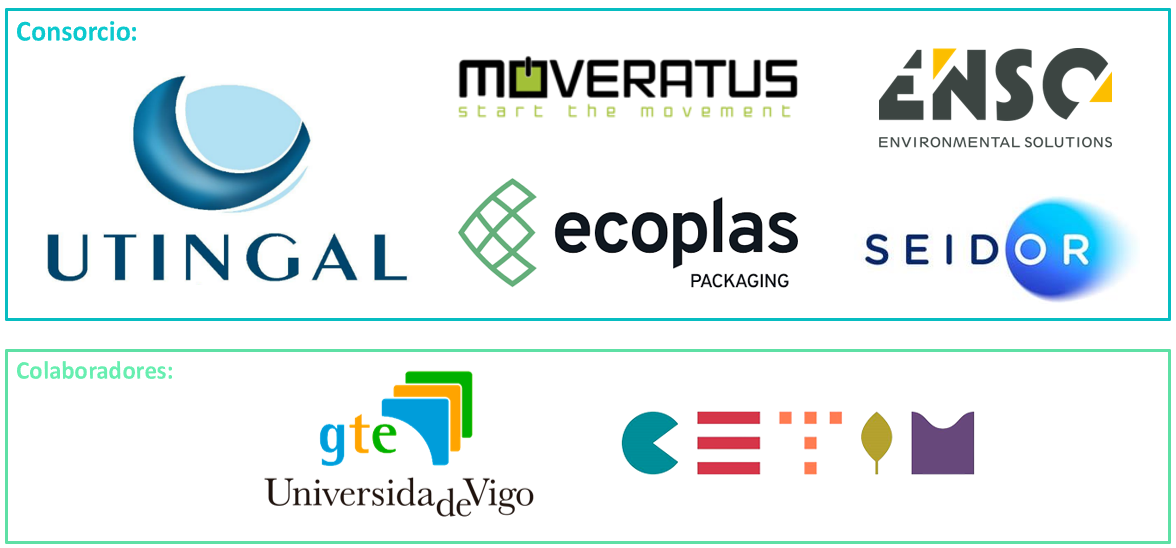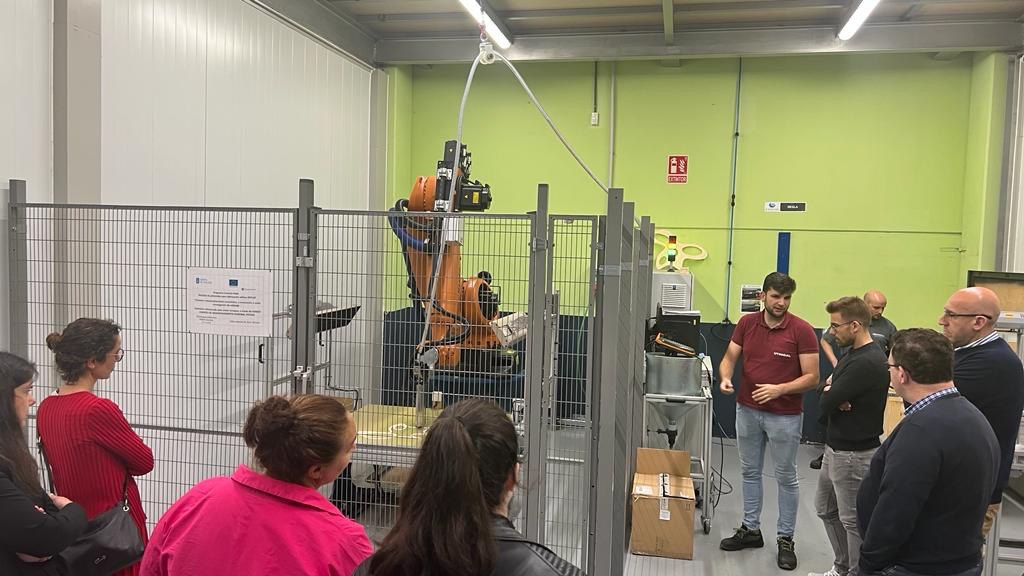The Galician Innovation Agency (GAIN) funded the REPLAY project within the framework of RIS3 Galicia (Conecta Hubs Programme) and co-financed by the European Regional Development Fund (ERDF) within the operational programme Feder Galicia 2014-2020.
The project “REPLAY”: REcycling of Polyamides for Additive manufacturing, is a proposal whose main objective is to generate the first comprehensive solution for recycling polyamides from various industrial sectors, giving them an added value use such as additive manufacturing, relying on new material formulations and advanced manufacturing processes optimised through the use of ICTs that will facilitate their deployment. The project included automated 3D printing tools capable of using recycled raw materials to generate new products.
To this end, a prototype recycling system was developed to use the waste from the UTINGAL processes (nylon vacuum bags) to obtain polyamide compounds for the manufacture of new customised parts for the aeronautical sector.
Five complementary companies (UTINGAL, MOVERATUS, ENSO, ECOPLAS, MSS SEIDOR) participated in this project and were able to solve the technological challenges in the three main areas that conditioned the project: chemistry, mechanics and automation-control. All of this was supported by two reference centres such as CETIM and UVIGO, which provided knowledge and support to the participants throughout the life of the project. Through its experience in Development Engineering, UTINGAL coordinated REPLAY with the aim of generating an integral industrial process for the continuous recycling of polyamides that can be exported in a simple and accessible way to any plastics industry.
UTINGAL is a company specialised in providing integral solutions for the aeronautical, automotive, defence and services sectors. With more than 20 years of experience, they provide a complete range of engineering services in the field of process control and industrial automation.

The project was divided into four activities that took place over three years:
- Activity A1 – Analysis of the most appropriate waste and processing methods according to their composition, overall emission balance and digitisation potential. The objectives of this activity were to characterise the starting materials to be reused, to study the most suitable production processes applicable to the reusable material, to identify possible additivation formulas and to determine the potential for reducing the overall carbon footprint.
- Activity A2 – Design of processes and methodologies for recycling plastic material used in the aeronautical industry based on circular economy. The objectives of this activity were the implementation of a system for the revaluation of polyamide bags to obtain several products from multiple polymeric formulations, and the validation of at least several optimised formulations based on recycled polyamide for the production of pellets for proof of concept for 3D printing and the production of mesh for packaging.
- Activity A3 – Design, manufacture and development of additive manufacturing system control (3D printing). The objective of this activity focused on the construction of a prototype 3D printing cell, the development of integrated management software for printing and the development of the first printing tests with recycled polyamide.
- Activity A4 – Validation of the additive manufacturing system (3D printing). The aim of the last activity was to test in practice the correct functioning of the prototype by means of various application cases.
During the first year, the starting materials and the most suitable production processes were characterised. FTIR studies, thermal analysis using DSC and TGA, fluidity index analysis and morphological analysis of each sample were carried out to determine its composition, degree of purity and recyclability. Technological monitoring was also carried out on pre-treatments, washing and drying systems for plastic waste from the aeronautical industry, as well as extrusion processes for recycled plastics, additives and compatibilising agents for polyamide. To check the reliability of the project, a carbon footprint and life cycle analysis of the polyamide bags used in the aeronautical industry was carried out in order to find out the effects that these processes have on the environment separately and what would be the best ways to avoid or reduce them.
During the second year, the different polyamide waste conditioning methodologies were studied, as well as their subsequent characterisation to determine the optimal processing conditions (input flows, optical separation, grinding, washing process, mechanical and thermal drying prior to the extraction process). In order to elaborate the different formulations by compounding processes, several different formulations of commercial and 3D printing polyamide 6 (NANOVIA3 and recycled PA) were carried out. The different formulations were used to know and compare the mechanical and thermal properties of each material obtained, thus determining their optimum. For this purpose, their thermal (by TGA) and mechanical (tensile and flexural) properties were characterised. Analyses were also carried out to determine the structure of the injected material, which was analysed by SEM (surface and fracture). Finally, its fluidity index was determined.
During the last months of this year, the key parameters affecting PA6 printing (printing speed, flow, temperature, etc.) were assessed and different printing tests were carried out by changing these settings. As conclusions of the activity carried out, it is highlighted that bed temperature and printing speed are crucial to obtain a good material. Finally, the techno-economic validation of the optimal polyamide formulation developed, which is based on 20% commercial PA6, 75% residual PA and 5% SCONA® TPPE 1102 PALL, was carried out by comparing it with the commercial printing polyamide. TGA tests have revealed that this material exhibits very similar thermal properties to commercial polyamide 6, as well as exhibiting suitable properties for additive manufacturing of 3D parts, making it technically feasible to use this composition.
In the third and last year, the construction of a prototype 3D printing cell, the development of integral management software for printing and the development of the first printing tests with recycled polyamide were carried out. The elements that make up the printing cell are a Kuka Robot, an extruder body, radiation heaters and other elements such as safety enclosure, heating table, table vacuum system, vacuum feeding system, electrical panel and communication software.
The robot arm was interconnected to the computer and the smartPAD for its control, so that it can be given the order to extrude the material. It has also been able to carry out calibrations and checks between the orders and the real movement of the arm. In the same line, a SIMATIC HMI panel was installed and programmed, an interface between the process and the operators that allows different parameters of the system to be visualised and allows individual values to be entered for non-automated 3D printing. For the management of the printed parts, the integration of the 3D printing control software was carried out, adding all the functions in a single environment, easy to handle and containing all the information.
Then, different extrusion tests were carried out with recycled material and applied to UTINGAL’s polyamide bags. A series of tasks were carried out focused on the study of the reuse behaviour of different thermoplastic materials, considering important aspects such as the degradation process that these materials undergo during their synthesis, processing, use and reprocessing through 3D printing.
Finally, the construction of the installation, the optimal formulation of the polyamide compound and printing tests were validated in order to optimise the parameters and obtain printed parts with recycled polyamide. Thus, at the end of the project, a prototype of the TRL 7 solution was obtained: “Demonstration of the system prototype in an operational environment” at UTINGAL’s Tui facilities.
During this phase it was possible to estimate that, with this prototype, the company is able to recycle 3,600 [kg] of polyamide bags per year, avoiding emissions of 39,708 [kg] of CO2 equivalent. Furthermore, the application of this waste revaluation system will mean a saving of 219,510 euros per year (87%) for UTINGAL when printing its own parts, as the total cost of parts printed with this material is estimated at 32,490 euros, while the acquisition of these same parts using steel (and manufactured by conventional methods) has a cost of 252,000 euros.
On 10 May 2023, UTINGAL, together with the rest of the participants and project managers, directly presented the results of the work carried out throughout the project to GAIN technician Joaquín García López. During this visit, the results were presented from a theoretical point of view and the deliverables of the various stages of development were shown, as well as a practical demonstration in UTINGAL’s own facilities.




Therefore, this initiative of the Conecta Hubs programme, financed by GAIN and co-financed by the European Regional Development Fund (Feder) within the Feder Galicia 2014-2020 operational programme, has made it possible to generate a specific tool for the reuse of plastic waste from industry, generating parts with high added value.

